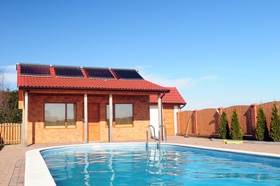
Solar Pool Heating
Using the Power of the Sun to Heat a Swimming Pool
![]() Solar Pool Heating is one of the most cost-effective use of solar energy today. The majority of swimming pools need some form of pool heating, either to increase the pools temperature during the spring and autumn seasons, or to help maintain a constant water temperature throughout the summer season when the pool is used the most. Generally, recreational and garden swimming pools only require a low temperature heat which is where non-concentrating solar flat plate collectors are at their most efficient.
Solar Pool Heating is one of the most cost-effective use of solar energy today. The majority of swimming pools need some form of pool heating, either to increase the pools temperature during the spring and autumn seasons, or to help maintain a constant water temperature throughout the summer season when the pool is used the most. Generally, recreational and garden swimming pools only require a low temperature heat which is where non-concentrating solar flat plate collectors are at their most efficient.
As we have seen previously, solar flat plate collectors capture free energy from the sun which can then be used to heat the water in your swimming pool providing an economical alternative to expensive conventional gas or electrical pool heaters.
By installing a solar pool heating system, the use of a normal swimming pool can be increased by up to four months a year just by using the heat energy from the sun. The type of solar pool heating system will vary for each pool design, location and available sunlight but the basic principal remains the same.
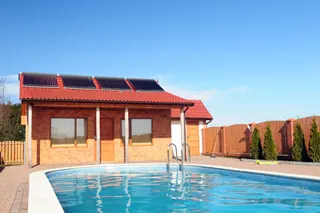
The swimming pool water is circulated through a flat panel solar collector, usually mounted on a roof or next to the pool, is heated by the suns solar energy and absorbed by the water flowing over or through it before the heated water is returned back to the pool.
Swimming pool heating systems do not require a separate water storage tank, since the pool itself serves as the storage tank and in most cases, the pools filtration pump can be used to circulate the swimming pool water through the solar panels making it an active system with force circulation.
Comfortable swimming water temperature is relatively low compared to other uses of hot water such as baths and showers. Flat panel solar collectors are most efficient at low temperatures and are therefore well suited for pool heating were a large volume of water has to be heated to just a few degrees above the ambient temperature rather than to heat a smaller quantity to a much higher temperature. A properly sized solar heating system can gently raise the pool temperature by at least 5 to 10oC (10 – 20oF) above the normal water temperature maintaining a comfortable swimming temperature each time the water passes through the solar collector.
Usually during the summer months when the suns solar energy is at its strongest, no pool heating is required and swimming in the pool should therefore be refreshing and comfortable when the ambient temperature and the suns strength are at their highest, so heating the pool water to as high a temperature as possible may not be desirable. This means that high temperatures say above 30oC (85oF) are not required. A pool water temperature of about 24 to 28oC (75 – 82oF) should be sufficient for the majority of people as the objective of a solar pool heating system is to heat a large amount of water by just a few degrees.
Also, a solar pool heating system can be used to cool a swimming as well as heat it. During the hottest part of the summer months, pumping the pools water through the solar system at night can cool a swimming pool down several degrees in one night to a more refreshing swimming temperature if the conditions are right as the flat panel collector can act as heat dispenser (radiator) to the surrounding cooler night time temperatures.
Such low pool temperature requirements can easily be met with a simple solar pool heating system using stationary flat panel collectors. They can heat water efficiently up to about 60oC (140oF), so there is plenty of margin and no need to use the more expensive evacuated tube or concentrating solar collectors. When it comes to flat panel collector types suitable for “solar pool heating”, there are many different ways to heat the water so here are a few of the more common designs.
Solar Pool Heating Designs
Black Pipe Solar – This type of solar pool heating system is very simple, cheap and can be installed in a matter of hours. The pool water is pumped through a coil or loop of black plastic polyethylene pipe laid in the sun and providing that the sun is shining directly onto plastic coil the water comes out the other end warmer.
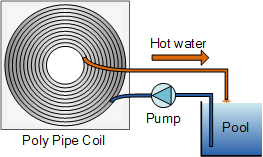
The advantage of using coils of polyethylene pipe is that the plastic pipe or hose up to 25mm (1") in diameter is relatively cheap to buy and easy to work with, so adding more pipe to the loop is inexpensive. Also, this type of solar pool heating system is very easy to change or modify to any size or length required.
The disadvantage however of black pipe solar loops, is their low efficiency in absorbing the solar energy, as well as a very large surface area or length of pipe is required to provide a significant amount of heat absorption. However, placing the pipe coil on top of aluminium foil sheet or providing reflectors around the pipe will improve its efficiency a little.
Since black pipe pool heaters only work in direct sunlight they suffer from high heat loss, so can only raise the water temperature inside the pipe a few degrees above ambient. The pipes plastic material such as: PVC, ABS, polypropylene, polyethylene, etc, is usually not very durable or resistant to direct sunlight either, because of the ultra-violet (UV) degradation of the polymer material, then the lifetime of this type of solar pool heating system is quite limited to a couple of seasons.
Open Collector Heating – Open collector solar pool heating panels, also known as trickle collectors, are basically sheets of metal with water flowing or “trickling” down over the top of them. The collectors absorber plate is painted black to maximise the absorption of the solar radiation, and is made from either a steel or a copper sheet, which collects the direct solar radiation and converts it into heat. Larger absorber plates increase the absorption surface area with the resulting heat being removed by the water flowing directly over the plate.
Typical Open Collector Solar Pool Heating Collector
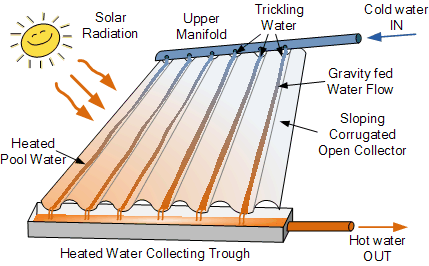
This type of solar pool heating system is very simple to construct and can easily be home made. The solar collector can be either a blackened flat panel or a corrugated type roofing sheet. The corrugated sheet is placed at an angle facing the sun and has a copper or plastic manifold at the top with a number of small holes along its length.
The swimming pools water is pumped from the pool into the top manifold. It then flows out of the holes at a low pressure and is allowed to trickle down the surface of the sheet with the aid of gravity absorbing the heat as it goes.
A metal trough or large plastic gutter pipe is located at the bottom of the sheet to collect the heated water which is then gravity fed or pumped directly to the pool. The pool water will be warmed by the sun’s radiation directly and by the transfer of heat from the collector itself.
Flat Plate Open Collectors sometimes use strips of rubber or silicon running vertically down the sheet to prevent the water from flowing to one side even if the collector is not perfectly aligned. The use of a corrugated sheets has the advantage that the water is evenly spread over the entire width of the collector as it will stay in the valleys of the sheet to be collected at the bottom.
While this type of solar pool heating collector is very simple and easy to make, it has the one big disadvantage in that it is not very efficient as a result of significant losses. Evaporation losses, in particular, are quite large because of the wind that can freely blow over the absorber surface cool it down as well as the wind blowing dust and dirt over the solar panel. Also over a period of time salts and other such dissolved particles will contaminate the panel as the water evaporates.
Open collector solar pool heaters are also very inefficient at higher water temperatures and/or low ambient temperatures such as cold or cloudy days as more energy can be lost through the panel on a cold day than is gained. Covering the absorber plate with a clear transparent flat or corrugated polycarbonate plastic or thin glass sheet will help reduce some of these losses but the increase in heat loss due to the warm air gap between the collector sheet and cover can obscure the glazing cover when it condenses thereby reducing the amount of solar radiation that hits the collector.
Sandwich Solar Collector – In a sandwich type flat panel solar collector, the pool water flows between two absorber metal plates (can also be moulded plastic) that are welded along their perimeter to form a sealed sandwich design. The two heat absorber plates, one called the upper plate and the other the lower plate, are also spot welded together at various intervals along the plate to form narrow gaps called channels, through which the water flows.

The circulating pool water enters the solar collector at one end, flows through the empty sandwiched design and leaves at the other end absorbing the heat from the collector as it goes. The water flow continues in this cycle, and the temperature increases gradually after each passage through the collector. Sandwich solar collectors are therefore active collectors as they require a pump to circulate the swimming pool water through this type of solar pool heating system.
The shape and size of the sandwich design is important to ensure a good bond between the water and the collector plate in order to maximise the rate of heat transfer between the two. Some plate designs incorporate dimples, embossing or flow restriction in the channels to stir-up the water inside the channels preventing it from flowing through the channels to fast thereby increasing its efficiency.
Sandwich Solar Collectors used for solar pool heating systems are much more efficient at transferring solar energy than the previous open collector type. Also, as unglazed sandwich solar collectors are sealed panels they do not suffer from wind and evaporation losses.
They are similar in design to integral collector storage or ICS collectors as the design of the channels may allow for a large volume of water to be stored within them adding to the structural weight if roof mounted. Their high flow rates and low system pressure allows for a maximum transfer of heat while reducing excess strain on the pump. Sandwich solar pool heaters can also be used in reverse at night to cool the pool water.
Unglazed Solar Collector – These types of solar pool heating collectors are simple and inexpensive with many different types of “unglazed” solar thermal collectors available specially designed for use as swimming pool heaters. The “sandwich” solar thermal collector above also belongs to the unglazed collector family.
Unglazed solar thermal collectors are specially designed for low-temperature applications making them ideal for the heating of swimming pools and spas and are therefore made from ultraviolet (UV) stabilised polypropylene plastic. Polypropylene plastic collectors are semi-rigid but become more flexible when heated by the sun. Unglazed solar collectors are light weight, come in a variety of shapes and sizes and the with correct maintenance and care can help heat a swimming pools water for up to 20 years.
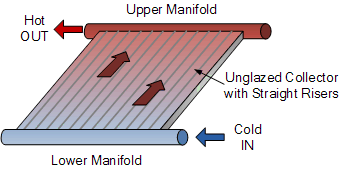
Unglazed solar pool heating systems, typically consist of a number of smooth or ribbed 1/4" (6mm) tubes running the length of the collector panel.
These thermally conductive tubes are either straight in a parallel configuration or are connected as one single continuous tube laid out in a curvy serpentine configuration. These heat absorbing riser tubes feed into much larger diameter top and bottom manifold pipes. A serpentine tube configuration eliminates the possibility of manifold leaks producing a more uniform flow.
Unglazed Solar Collectors are very similar in design to standard flat panel collectors. Their design is characterised by the lack of transparent glass or polycarbonate cover (hence their name “unglazed” collector) and thermal insulation.
This is because the collector is heating a pool to the same ambient temperature surrounding the pool and has little or no thermal loss, therefore it does not need to be insulated. Then the water temperature generated by an unglazed solar pool collector is dependent on the outside air temperature so does not work efficiently unless the ambient temperature is higher than the swimming pool temperature. When it is required to heat the pool to a higher temperature it becomes more important to insulate the collector otherwise the convection losses will be unacceptably high.
Because unglazed pool collectors have no glass cover, the solar absorber often operates with a higher efficiency than glazed collectors. This is due to the fact that the transparent glass (or polycarbonate) cover can block or reflect as much as 20% of the incoming solar radiation, then under certain conditions, they can operate with a efficiency than standard glazed hot water collectors. However, efficiency quickly drops if the pool temperature is greater than about 6 to 8oC above ambient temperature. Also, the surrounding wind speed has a negative effect on the absorber efficiency.
Glazed Solar Collector – used for solar pool heating systems are very similar to their domestic hot water cousins detailed in the previous tutorials. A glazed solar collector consists of stainless steel or other such tube materials which are not affected or corroded by the pools chemicals which are attached to a black metal absorber plate. The plate and tubes are housed within an insulated box and covered with a sheet of glass or polycarbonate sheet (hence their name “glazed” collector) to prevent heat loss.
The transparent cover reduces heat loss out of the front of the collector, while insulation can prevent heat loss to the back and sides. This means that they can operate at a higher temperature and are less affected by wind, rain and cool air temperatures.
Glazed Solar Collectors are more commonly used for indoor swimming, health or hydrotherapy pools and spas that usually require a higher water temperature. Glazed solar collectors can also be used for outdoor pools in cool or windy climates for year round pool heating. However, the disadvantage of glazed collectors is that they are more expensive than other forms of solar pool heating, making their use as solar pool heating system less attractive.
Additionally, as well as heating just the pools water, glazed solar collectors can also be used within a swimming pool environment if there is a need for hot water in the changing rooms. For example, solar thermal collectors can be used to heat the domestic hot water supply for use in changing room showers, baths, etc.
Hot Tubs and Spas – Glazed solar collectors can also be used for the heating of hot tubs and spas. The water temperature required for these is hotter than for a standard swimming pool with typically temperatures reaching over 40oC (100oF).
The volume and exposed surface area of the water inside a hot tub or spa is much less than a pool and therefore a smaller sized solar thermal collector can be used. The high water temperature creates a large energy requirement, especially when a tub has cooled down over night or when not in use so glazed solar collectors are generally used since they can heat the water to a much higher temperatures.
Solar Pool Heating Sizing
The different solar pool collectors described above are just a few examples of the many different types of absorber plate and water passage designs that exist today for use in a solar pool heating system, each with their individual advantages and disadvantages.
The size of the solar collector required for solar pool heating is determined by many factors, including: geographic location; size and shape of pool; desired pool temperature, swimming season, and length of time required to reheat the pool as well as wind conditions and shading from trees, walls or fences, etc but a general rule of thumb is that you will need a system that is equal to about 50 to 80% of the pool surface area. That is the surface area of the water and not the volume of water.
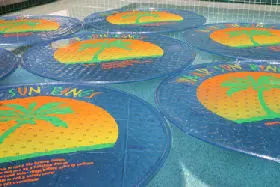
Solar thermal panels for use in swimming pool heating systems are available in standard panel sizes of 4´x 8´, 4´x 10´, 4´x 12´ which can be mounted next to the pool or on an adjacent roof making the installation of pump, filter and tubing much easier.
Swimming pool heating is a popular application of the solar thermal energy provided free by the sun and installing a solar pool heating system can save you a lot of money over a more conventional and standard type electrical or gas powered Swimming Pool Heater.
If your pool is in direct sunlight, the sun helps to raise and maintain the water temperature free of charge. In many cases, you can add a solar system to your existing filter pump and plumbing he


